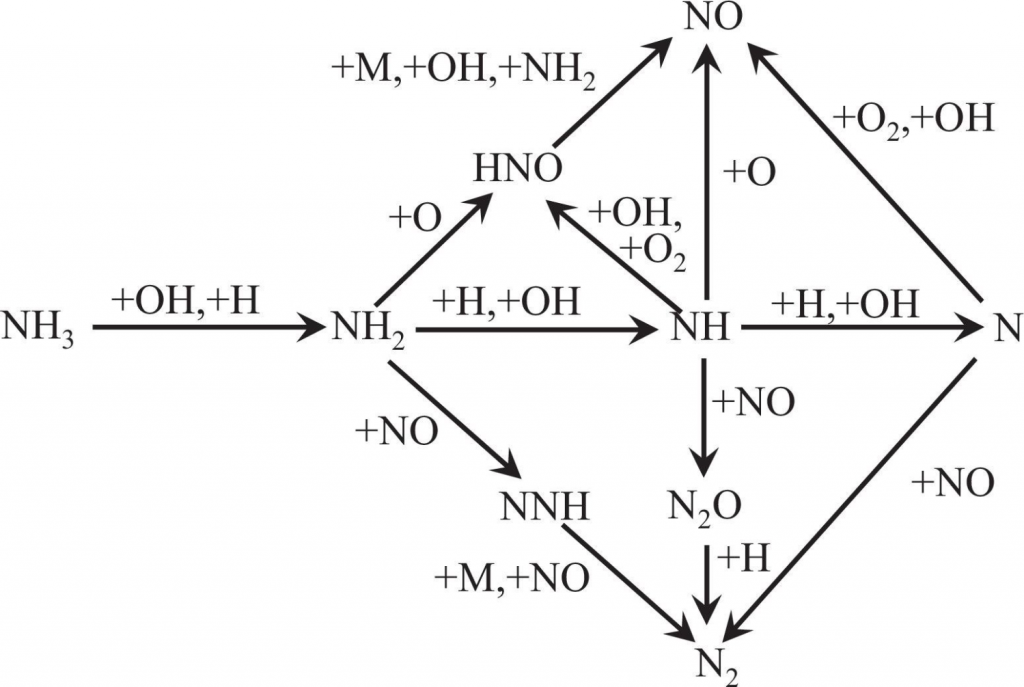The main challenge during the combustion of NH3 is the production of NOx. According to the J.A Miller during the combustion of NH3, NO is a major product.
Reduction of NO:
The reaction of NO with NHi (i = 0, 1, 2) leads to the reduction of NO to N2. NO reduction by NH primarily produces N2O via NH + NO = N2O + H. N2O is then largely consumed through N2O + H = N2+ OH. The dominant NO reduction step under all conditions, especially in lean flames, is the reaction of NO with NH2, which has two product channels, NH2+ NO = NNH + OH – (R1) and NH2+ NO = N2+ H2O – (R2).
R.K Lyon found that within a certain temperature range and oxygen concentration, NOx reduction in flames can be enhanced using NH3 in a process called Thermal DeNOx. Studies by R.K Miller and a host of subsequent studies explained that the NH2+ NO reactions are key to the thermal DeNOx process. The self-sustaining character of the DeNOx mechanism is due to the direct or indirect production of OH and O from R1 at a rate controlled by the branching ratio, α=k1/(k1+k2), and the lifetime of NNH. NNH promotes the production of OH and O through the steps NNH = N2+ H, H + O2= O + OH, and O + H2O = OH + OH. The smaller the branching ratio, the slower the chain-branching R1 relative to the chain-terminating R2. Consequently, there is an increased tendency to hinder the production of O/H radicals, which sustains the conversion of NH3 to NH2 for a continuation of NO reduction.
On the other hand, a large α may result in the substantial promotion of O/H radical production, given the very short lifetime of NNH (10−11 to 10−8 s) proposed by theoretical studies. Consequently, conversion of NH2 to NO rather than NO reduction may be favored. The sensitivity of the thermal DeNOx process to the concentration of O/H radicals contributes to its dependence on temperature. At the lower boundary of the effective thermal DeNOx temperature window, the chain-terminating reaction H + O2+ M = HO2+ M competes with H + O2= O + OH and hence inhibits the thermal DeNOx process. On the other hand, above the upper-temperature boundary, there is significant growth in the O/H radical pool, leading to net NO production rather than reduction. It can thus be understood that the NO formation/reduction in ammonia flames, as well as the reactivity of the N/H/O chemistry, may be significantly dependent on α and the lifetime of NNH, H. Nakamura concluded that α is a key parameter controlling ammonia reactivity.
The advantages of ammonia are not only that it is a hydrogen carrier, but also its availability, amenability to storage and transport, and its utility as a fuel for various energy and industrial applications. The combustion of ammonia, which is the most effective way to use ammonia as an energy source, is a key technology. Challenges such as low flammable characteristics and fuel NOx emission can be overcome by the knowledge of the dynamics and chemistry of combustion.
The recent transportation of Ammonia from Saudi Arabia to Japan is interesting, as it shows that the various limitations during the combustion of ammonia have been dealt with. It marches the oil-rich country towards carbon-free energy.
Written by Mr. Sakkir Hussain, Director-International Business at TNC


